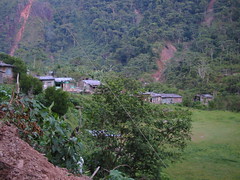Sarita and Carlito accompany us through this experience, teaching the language of a world we didn’t know before, the keys in order to understand and respect the forest. They design in our minds the symbols of nature: the anaconda (amaru), the boa, the sangre de drago (dragon blood, a medicinal resin), the butterflies, the curative plants used by the community and the shamans. Ayahuasca (the word which means “vine of the spirits” in Quechua language) or yagé, is a traditional psychotropic infusion considered sacred by the indigenous peoples in all the river basin of the Amazonian forest. It comes prepared by the shamans or curanderos in infusion and it’s consumed by night, as an instrument to expand their own mind and perception of nature. In the Napo region, Equador, it’s known with three different names:
- Ayahuasca de las Mujeres, visions of flowers.
- Ayahuasca de los Hombres, visions of boas.
- Ayahuasca de los Fantasmas, visions of spirits.



